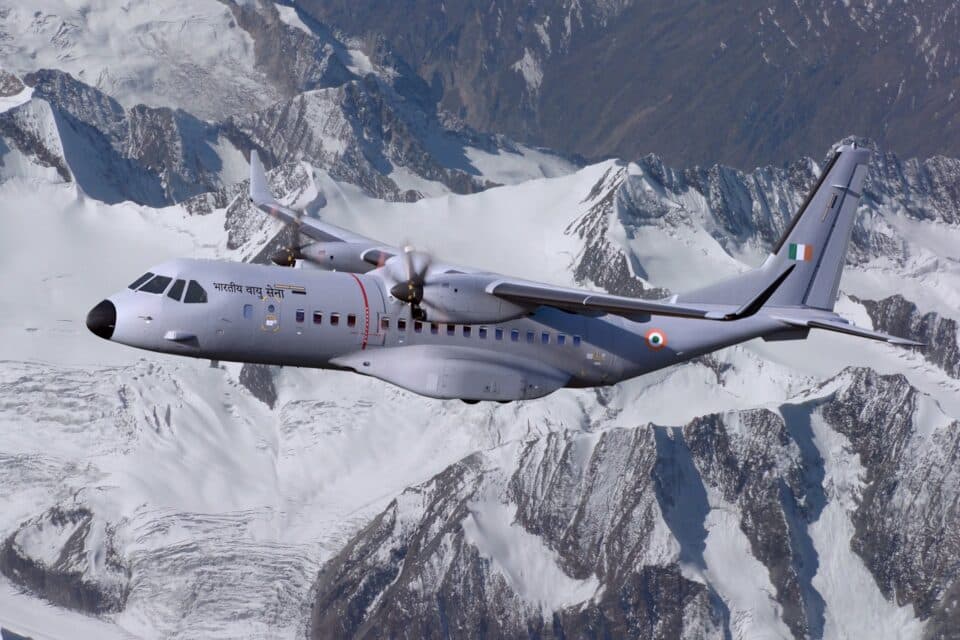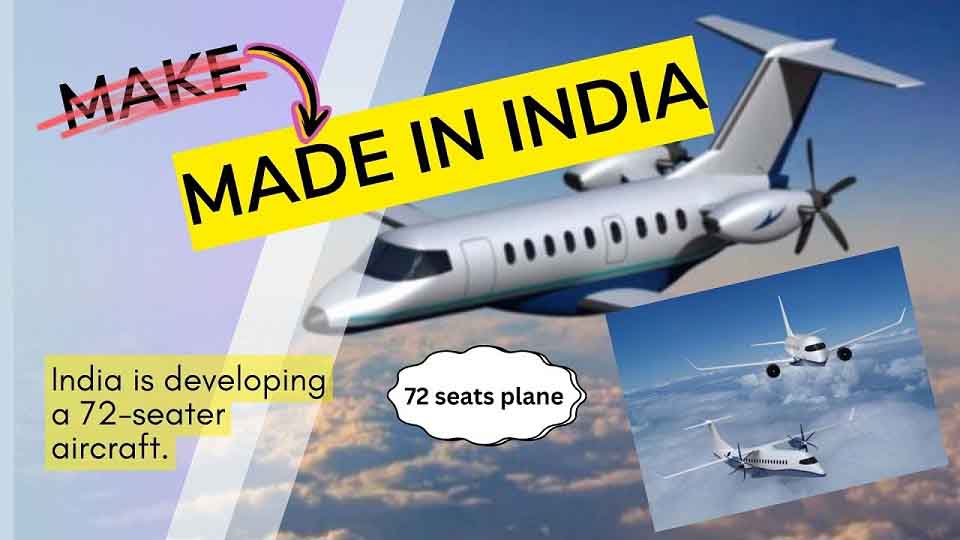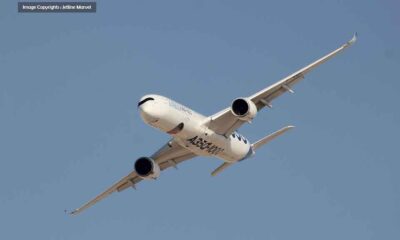Aviation
India formalises acquisition of 56 Airbus C295 aircraft

New Delhi, 24 September 2021 – India has formalized the acquisition of 56 Airbus C295 aircraft to replace the Indian Air Force (IAF) legacy AVRO fleet. It is the first ‘Make in India’ aerospace programme in the private sector, involving the full development of a complete industrial ecosystem: from the manufacture to assembly, test and qualification, to delivery and maintenance of the complete lifecycle of the aircraft.
Under the contractual agreement, Airbus will deliver the first 16 aircraft in ‘fly-away’ condition from its final assembly line in Seville, Spain. The subsequent 40 aircraft will be manufactured and assembled by the Tata Advanced Systems (TASL) in India as part of an industrial partnership between the two companies.
The first 16 aircraft will be delivered over four years after the contract implementation. All the IAF C295s will be handed over in transport configuration and equipped with an indigenous Electronic Warfare Suite.
“This contract will support the further development of India’s aerospace ecosystem, bringing investment and 15,000 skilled direct jobs and 10,000 indirect positions over the coming 10 years,” said Michael Schoellhorn, CEO of Airbus Defence and Space. “The C295 has proven again as the segment leader, and with the addition of India as a new operator, the type will enlarge its footprint even more, not only on the operational aspects but on its own industrial and technological development”.
Sukaran Singh, Managing Director and Chief Executive Officer, Tata Advanced Systems Limited, said, “This is a moment of pride for Tatas and a milestone for the Indian military manufacturing ecosystem. For the first time, an Indian private company will be wholly manufacturing an aircraft in India. This endeavour demonstrates Tata Advanced Systems’ capabilities as a defence manufacturer to build globally competitive complex platforms in India.”
‘Make in India’ is at the heart of Airbus strategy in India, with the company constantly increasing the country’s contribution to its global product portfolio. The C295 programme will see Airbus bring its complete bouquet of world-class aircraft manufacturing and servicing to India in collaboration with our industrial partners, including the Tatas and leading defence public sector units such as Bharat Electronics Ltd. and Bharat Dynamics Ltd, as well as private Micro, Small and Medium Enterprises.
Top 5 features of F35 Lockheed martin fighter jet
With a proven capability of operating from short or unprepared airstrips, the C295 is used for tactical transport of up to 71 troops or 50 paratroopers, and for logistic operations to locations that are not accessible to current heavier aircraft. It can airdrop paratroops and loads, and also be used for casualty or medical evacuation (medevac), as demonstrated during the COVID-19 crisis, using either basic litters or mobile intensive care units (ICU) with life support equipment. The aircraft can perform special missions as well as disaster response and maritime patrol duties.
THE GULFSTREAM G700 SETS INTERNATIONAL CITY-PAIR SPEED RECORDS FOR THE FIRST TIME.
The IAF becomes the 35th C295 operator worldwide, with the programme reaching 278 aircraft, 200 of which are already in operation and have booked more than half a million flight-hours.
@AirbusDefence #C295 #TeamAirbus #MakeinIndia
Airbus aims A350 Freighters in the skies within 2025

Aviation
AI’s Potential to Replace Pilots in Future U.S. Warplane Operations Raises Concerns, Expert Warns

Can you believe that an F16 Fighter jet is now being flown by an Artificial Intelligence system? Yes, you heard it right. With ongoing efforts to reduce human involvement, a system has been created to pilot these fighter jets. Experts are actively training this AI system in the art of flying fighter jets.
This groundbreaking initiative is being conducted by the U.S. Air Force Test Pilot School, alongside various government and industry partners, with the recent participation of U.S. Secretary of the Air Force Frank Kendall for a flight aboard the X-62A Variable In-flight Simulation.
VISTA, short for Variable In-flight Simulation of Aircraft, stands as a pioneer in AI development, paving the way for the exploration and testing of advanced AI techniques within innovative unmanned vehicle designs.
In recent updates, teams have successfully integrated initial live AI agents into the systems of the X-62A, marking a significant step forward. This milestone was accompanied by the inaugural AI versus human dogfight and the implementation of over 100,000 lines of flight-critical software modifications across 21 test flights.
Leading the forefront is Lockheed Martin, pioneering the integration of AI-enabled platform autonomy alongside human oversight. This approach aims to boost operational speed, enhance agility, and trim sustainment costs.
The F16 stands tall as one of the most formidable fighter jets globally, renowned for its versatility in weaponry and battle-tested single-engine design. Despite its tenure in the US Air Force fleet, it has received the latest upgrades in Avionics and Weapons systems, ensuring its continued relevance.
A significant stride made by Lockheed Martin and the US Air Force involves the incorporation of AI technology, enabling automated aircraft control. Among various aircraft experimented with, the F16 emerges as a standout platform in this venture. This achievement marks a historic milestone, as the F16 becomes the world’s first fighter jet to be controlled by AI technology.
Lockheed Martin has showcased AI flight capabilities for aircraft like the Black Hawk helicopter, but this marks the first instance of an AI system piloting a fighter jet.
Some experts warn of potential dangers, highlighting concerns such as the risk of the AI losing control and triggering missiles indiscriminately. They argue that AI lacks the capacity for human judgment necessary in certain situations, posing potential risks during flight testing.
However, others see potential benefits, such as aiding pilot training and enabling autonomous flight in emergencies. They suggest that AI-operated aircraft could be instrumental in rescuing pilots or handling critical situations.
From a military perspective, the absence of human pilots could offer strategic advantages for the US Air Force. Unmanned F-16 fighter jets armed with lethal weaponry could penetrate enemy territory and complete missions without risking valuable pilots.
While the platform is still in development, it’s expected to become even more advanced than existing fighter jets in the near future.
However, concerns also abound regarding the potential dangers associated with deploying unmanned fighter jets. Questions arise about the reliability of autonomous systems in high-stakes combat situations, as well as the ethical considerations surrounding the use of lethal force without direct human oversight. Additionally, the possibility of cyberattacks targeting these unmanned aircraft raises significant security concerns.
Ultimately, the debate surrounding pilotless F16 fighter jets underscores the complex intersection of technology, ethics, and national security. While proponents argue for the potential benefits in terms of defense capabilities, detractors raise valid concerns about safety, accountability, and the broader implications for the future of warfare.
Aviation
AI pilot operates experimental F-16 fighter jet

Lockheed Martin Skunk Works® (NYSE: LMT) recently collaborated with the U.S. Air Force Test Pilot School and various government and industry partners to host U.S. Secretary of the Air Force Frank Kendall for a flight aboard the X-62A Variable In-flight Simulation Test Aircraft (VISTA). This aircraft is unique, having been modified specifically for testing artificial intelligence (AI) and autonomy capabilities.
VISTA serves as a trailblazer in AI development, facilitating the exploration and testing of cutting-edge AI techniques within novel unmanned vehicle designs. This work is crucial for achieving distributed teaming objectives. Remarkably, within a span of less than a year, the teams successfully integrated initial live AI agents into the systems of the X-62A, showcased the inaugural AI versus human dogfight, and implemented over 100,000 lines of flight-critical software modifications over 21 test flights.
“The need for innovation at speed and scale is greater than ever. The X-62A VISTA is a crucial platform in our efforts to develop, test, and integrate AI, as well as to establish AI certification standards that will revolutionize the future of aerospace,” said John Clark, Vice President and General Manager of Lockheed Martin Skunk Works. “Our proven hardware and software architecture create secure and controlled environments for AI agents and sophisticated algorithms to swiftly prototype and evolve.”
Lockheed Martin’s open systems architecture, leveraging Skunk Works’ Model Following Algorithm (MFA) and System for Autonomous Control of the Simulation (SACS), facilitates intricate tests. These significant enhancements augment VISTA’s capabilities while preserving its advantage in rapid prototyping, allowing for swift software adjustments and frequent flight tests. This expedites the pace of AI and autonomy development to align with pressing national defense priorities.
This architecture has demonstrated reliability and robustness, capable of transitioning to third-party distributed hardware to replicate safe and controlled flight test objectives, as demonstrated by VISTA. Lockheed Martin leads the charge in integrating AI-enabled platform autonomy with human oversight to enhance operational speed, optimize agility, and reduce sustainment costs.
The F16 is renowned as one of the deadliest fighter jets in existence, boasting a versatile array of weaponry and a proven track record in battle with its single-engine design. Despite being among the oldest fighter jets in the US Air Force, it has received the latest upgrades in Avionics and Weapons systems. A significant milestone achieved by Lockheed Martin and the US Air Force is the integration of AI technology, enabling automated control of the aircraft. While Lockheed Martin has experimented with various aircraft, the F16 stands out as a unique platform in this regard. It marks a historic achievement as the world’s first fighter jet to be controlled by AI technology.
Secretary Kendall’s flight closely follows several notable accolades for VISTA, including nominations as finalists for the 2023 Robert J. Collier Trophy and receipt of the Society of Flight Test Engineers’ James S. McDonnell Award and Aviation Week’s 2024 Laureate Award for Defense.
Aerospace
India is currently in the process of developing its own 72-seater aircraft.

India stands on the cusp of pioneering its aircraft development, a potential reality in the near future. With the Indian aviation market poised to become one of the world’s top five largest markets, there’s a burgeoning demand for carriers like Indigo, Air India, and Akasa. Together, they’ve placed orders for over 1400 aircraft from Boeing and Airbus, marking one of the highest orders in the aviation industry.
‘Made in India’ passenger aircraft.
To transform the dream of a ‘Made in India’ passenger aircraft into reality and propel the local aerospace ecosystem, India requires a comprehensive National Aerospace Policy. Notably, Airbus and Boeing have yet to establish final aircraft assembly lines (FALs) within India, spurred by the significant orders received.
India has exerted considerable pressure to establish assembly lines domestically, mirroring the success of similar initiatives abroad. With its aviation market growing at an unprecedented rate, India boasts the largest order book for new aircraft, estimated at a staggering $70 billion over the next decade. Existing airports bustle with travelers while new ones are either under construction or in the planning phase.
The timeline for India to realize the Prime Minister’s vision of a Made in India commercial aircraft hinges on various factors. Leveraging its prowess in exporting IT services and aerospace technologies, India is poised for the next stage of development.
The success rate of China’s C919 and ARJ21.
In the realm of commercial aerospace manufacturing, Europe and the US have long held the reins, but China has emerged as a formidable contender in recent years. China’s journey began in 2002 with the ARJ21, a regional jet, and later the C919, a larger narrow-body aircraft. While the ARJ21 encountered delays and is seen as a modest achievement, the C919 boasts over one thousand orders, marking a significant success.
Both programs heavily rely on foreign technologies sourced from global original equipment manufacturers (OEMs), underscoring the importance of collaborations and creating an appealing environment for foreign companies to operate within China.
Indian HAL has 80 years of history.
India, too, boasts a rapidly growing aerospace sector that traces its roots back to pre-independence times, predating China’s endeavors by over 60 years. Hindustan Aeronautics Ltd (HAL), initially established as Hindustan Aircraft Ltd in 1940, spearheaded this journey. Given its early establishment, India was poised to become a major player in aerospace manufacturing.
HAL shoulders much of the responsibility for developing aircraft for defense purposes, including the TEJAS, attack and multirole helicopters, trainer aircraft, and notably, the Dornier D228, a passenger version aircraft representing a significant breakthrough for the Indian Aerospace Industry. Demand for helicopters is also on the rise, further showcasing India’s potential in the aerospace domain.
India’s aviation market Demand.
One drawback in the defense sector is the inherent uncertainty surrounding government budgets and delays in allocating funds for helicopter purchases. On the civilian front, aircraft demand remains consistently high, especially when they meet passenger needs and receive regular approvals from authorities.
India’s aviation market is distinct, calling for unique aircraft programs. With a high density of flyers, there’s a prevalent preference for short-haul flights from rural areas to major cities. As the air travel network expands to Tier-2 and Tier-3 cities, the number of operational airports is expected to surge from the current 140 to 230-240.
The demand for smaller aircraft, particularly for serving Tier 1-3 cities, is paramount for airlines. While the Dornier aircraft has been utilized for some routes, its availability limitations and noise levels have raised concerns. Jet planes emerge as preferable options for Indian travelers due to their efficiency and comfort, aligning better with the needs of airlines.
Establishing a sustainable aircraft program requires long-term commitment and substantial risk capital, often necessitating government support akin to what’s observed in developed markets. For instance, COMAC, over its lifetime, received significant state-related support ranging from $49-72 billion, while Airbus, over the years, obtained $22 billion from the EU.
Encouraging private investment is crucial for fostering growth in the aerospace sector and nurturing indigenous aircraft development in India. Such initiatives could significantly bolster the country’s aviation industry and enhance its self-reliance in this critical domain.
Indian Regional Jet (IRJ).
Introducing the Indian Regional Jet (IRJ), a cutting-edge project led by India’s National Aerospace Laboratories (NAL) and set to be manufactured by Hindustan Aeronautics Limited (HAL). This regional airliner aims to redefine air travel with its design, offering a capacity of 80–100 passengers. The base model, known as the RTA-70, will boast 80–90 seats while distinguishing itself with a cost that’s 20 percent lower than its global counterparts.
Development is well underway, with plans for a 90-seater variant expected to take flight by 2026. This next-generation aircraft promises impressive specs, including a range of 1,350 nm (2,500 km), and requiring a take-off and landing field length of 900m (2,950 ft). With dimensions of 28.6m in length and a wingspan of 29.4m, it reaches a service ceiling of 30,000 ft and cruises at 300kt, all while meeting Stage 4 noise criteria.
Saras Aircraft.
Meanwhile, NAL’s innovative spirit extends to the NAL Saras, another project in the works. Already, prototypes like the Mark1 and its successor, the second version dubbed ‘Mark 2,’ are pushing boundaries. The Saras Mark 2 showcases versatility, offering ranges of 600 km with 19 passengers, 1,200 km with 14 passengers, and an impressive 2,000 km with eight passengers. With a top cruise speed exceeding 600 km/h and an endurance of six hours, it’s a game-changer.
Weights
Max. take-off : 7600 kg (16755 lb)
Operating empty wt. : 5100 kg (11244 lb)
Max. fuel weight : 1832 kg (4039 lb)
Max. pay load : 1710 kg (3770 lb)
Power plant
SARAS is powered by two Pratt and Whitney Canada.
PT6A-67A turbo-prop engines (flat rated to 1200 shp)
driving 2.6 m diameter 5 bladed constant speed propellers
at 1700 rpm in a Tractor configuration.
Main dimensions
Span : 18 m (59.05 ft)
Length : 17.3 m (56.8 ft)
Height : 5.5 m (18 ft)
Performance (ISA)
Take-off distance : 820 m (2690 ft)
Landing distance : 665 m (2182 ft)
Max. rate of climb : 10 m/s (1980 ft/min)
Max. range* (19 pax) : 750 km (405 nm)
Max. range* (10 pax) : 2350 km (1270 nm)
Ferry range* : 2400 km (1295 nm)
Max. cruise speed : 485 km/hr (260 Kts)
Endurance : 6 hours . With 45 min reserve
Equipped with propeller engines initially, the Saras is poised for future upgrades to jet engines if project requirements align. NAL’s ambition shines through in its cost-effective approach, targeting ₹50 crore per unit for the Saras Mk2, undercutting the ₹55 crore Dornier 228 with its unpressurized cabin and altitude restrictions. Anticipating government support, NAL aims to secure orders for 50-60 units to ensure manufacturing viability, with an initial order of 15 aircraft from the Indian Air Force potentially expanding to 120–140 units in the coming years.


























